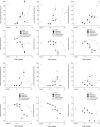Abuse liability profile of three substituted tryptamines
- PMID: 21474568
- PMCID: PMC3126641
- DOI: 10.1124/jpet.111.179705
Abuse liability profile of three substituted tryptamines
Abstract
The abuse liability profile of three synthetic hallucinogens, N,N-diisopropyltryptamine (DIPT), 5-N,N-diethyl-5-methoxytryptamine (5-MeO-DET), and 5-methoxy-α-methyltryptamine (5-MeO-AMT), was tested in rats trained to discriminate hallucinogenic and psychostimulant compounds, including cocaine, methamphetamine, 3,4-methylenedioxymethylamphetamine (MDMA), lysergic acid diethylamide (LSD), (-)-2,5-dimethoxy-4-methylamphetamine (DOM), and dimethyltryptamine (DMT). Because abused hallucinogens act at 5-hydroxytryptamine 1A (5-HT(1A)) and 5-HT(2A) receptors, and abused psychostimulants act at monoamine transporters, binding and functional activities of DIPT, 5-MeO-DET, and 5-MeO-AMT at these sites were also tested. DIPT fully substituted in rats trained to discriminate DMT (ED(50) = 1.71 mg/kg) and DOM (ED(50) = 1.94 mg/kg), but produced only 68% LSD-appropriate responding. 5-MeO-DET fully substituted for DMT (ED(50) = 0.41 mg/kg) and produced 59% MDMA-appropriate responding. 5-MeO-AMT did not fully substitute for any of the training drugs, but produced 67% LSD-appropriate responding. None of the compounds produced substitution in rats trained to discriminate cocaine or methamphetamine. All three compounds showed activity at 5-HT(1A) and 5-HT(2A) receptors as well as blockade of reuptake by the serotonin transporter. In addition, 5-MeO-AMT produced low levels of serotonin release and low potency blockade of dopamine uptake. DIPT, 5-MeO-DET, and 5-MeO-AMT produced behavioral and receptor effects similar to those of abused hallucinogens, but were not similar to those of psychostimulants. DIPT and 5-MeO-DET may have abuse liability similar to known hallucinogens and may be hazardous because high doses produced activity and lethality.
Figures


Similar articles
-
Receptor interaction profiles of novel psychoactive tryptamines compared with classic hallucinogens.Eur Neuropsychopharmacol. 2016 Aug;26(8):1327-37. doi: 10.1016/j.euroneuro.2016.05.001. Epub 2016 May 20. Eur Neuropsychopharmacol. 2016. PMID: 27216487
-
A systematic study of changes in monoamine neurotransmitters in the rat brain following acute administration of alpha-methyltryptamine (AMT), 5-methoxy-alpha-methyltryptamine (5-MeO-AMT) and 5-methoxy-N,N-diisopropyltryptamine (5-MeO-DiPT).Neurosci Res. 2025 Jul;216:104903. doi: 10.1016/j.neures.2025.04.006. Epub 2025 Apr 25. Neurosci Res. 2025. PMID: 40288614
-
Discriminative stimulus effects of N,N-diisopropyltryptamine.Psychopharmacology (Berl). 2013 Mar;226(2):241-6. doi: 10.1007/s00213-012-2891-x. Epub 2012 Oct 16. Psychopharmacology (Berl). 2013. PMID: 23070023 Free PMC article.
-
The hallucinogenic world of tryptamines: an updated review.Arch Toxicol. 2015 Aug;89(8):1151-73. doi: 10.1007/s00204-015-1513-x. Epub 2015 Apr 16. Arch Toxicol. 2015. PMID: 25877327 Review.
-
Clinical toxicology of newer recreational drugs.Clin Toxicol (Phila). 2011 Oct;49(8):705-19. doi: 10.3109/15563650.2011.615318. Clin Toxicol (Phila). 2011. PMID: 21970769 Review.
Cited by
-
Neurochemical pharmacology of psychoactive substituted N-benzylphenethylamines: High potency agonists at 5-HT2A receptors.Biochem Pharmacol. 2018 Dec;158:27-34. doi: 10.1016/j.bcp.2018.09.024. Epub 2018 Sep 25. Biochem Pharmacol. 2018. PMID: 30261175 Free PMC article.
-
Molecular Docking Assessment of Cathinones as 5-HT2AR Ligands: Developing of Predictive Structure-Based Bioactive Conformations and Three-Dimensional Structure-Activity Relationships Models for Future Recognition of Abuse Drugs.Molecules. 2023 Aug 24;28(17):6236. doi: 10.3390/molecules28176236. Molecules. 2023. PMID: 37687065 Free PMC article.
-
Discriminative and locomotor effects of five synthetic cathinones in rats and mice.Psychopharmacology (Berl). 2015 Apr;232(7):1197-205. doi: 10.1007/s00213-014-3755-3. Epub 2014 Oct 5. Psychopharmacology (Berl). 2015. PMID: 25281225 Free PMC article.
-
Discriminative Stimulus Effects of Substituted Tryptamines in Rats.ACS Pharmacol Transl Sci. 2020 Dec 29;4(2):467-471. doi: 10.1021/acsptsci.0c00173. eCollection 2021 Apr 9. ACS Pharmacol Transl Sci. 2020. PMID: 33860176 Free PMC article.
-
Methylenedioxymethamphetamine-like discriminative stimulus effects of seven cathinones in rats.Behav Pharmacol. 2020 Jun;31(4):378-384. doi: 10.1097/FBP.0000000000000540. Behav Pharmacol. 2020. PMID: 31895060 Free PMC article.
References
-
- Adkins EM, Barker EL, Blakely RD. (2001) Interactions of tryptamine derivatives with serotonin transporter species variants implicate transmembrane domain I in substrate recognition. Mol Pharmacol 59:514–523 - PubMed
-
- Cheng Y, Prusoff WH. (1973) Relationship between the inhibition constant (K1) and the concentration of inhibitor which causes 50 per cent inhibition (I50) of an enzymatic reaction. Biochem Pharmacol 22:3099–3108 - PubMed
-
- Cozzi NV, Gopalakrishnan A, Anderson LL, Feih JT, Shulgin AT, Daley PF, Ruoho AE. (2009) Dimethyltryptamine and other hallucinogenic tryptamines exhibit substrate behavior at the serotonin uptake transporter and the vesicle monoamine transporter. J Neural Transm 116:1591–1599 - PubMed
-
- Deneau G, Yanagita T, Seevers MH. (1969) Self-administration of psychoactive substances by the monkey. Psychopharmacologia 16:30–48 - PubMed
-
- Eshleman AJ, Carmolli M, Cumbay M, Martens CR, Neve KA, Janowsky A. (1999) Characteristics of drug interactions with recombinant biogenic amine transporters expressed in the same cell type. J Pharmacol Exp Ther 289:877–885 - PubMed
Publication types
MeSH terms
Substances
Grants and funding
LinkOut - more resources
Full Text Sources
Medical

